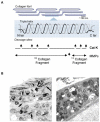Cathepsin K inhibitors for osteoporosis and potential off-target effects
- PMID: 19388876
- PMCID: PMC3110777
- DOI: 10.1517/13543780902832661
Cathepsin K inhibitors for osteoporosis and potential off-target effects
Abstract
Cathepsin K is a highly potent collagenase and the predominant papain-like cysteine protease expressed in osteoclasts. Cathepsin K deficiencies in humans and mice have underlined the central role of this protease in bone resorption and, thus, have rendered the enzyme as an attractive target for anti-resorptive osteoporosis therapy. In the past decade, a lot of efforts have been made in developing highly potent, selective and orally applicable cathepsin K inhibitors. Some of these inhibitors have passed preclinical studies and are presently in clinical trials at different stages of advancement. The development of the inhibitors and preliminary results of the clinical trials revealed problems and lessons concerning the in situ specificity of the compounds and their tissue targeting. In this review, we briefly summarize the history of cathepsin K research and discuss the current development of cathepsin K inhibitors as novel anti-resorptives for the treatment of osteoporosis. We also discuss potential off-target effects of cathepsin K inhibition and alternative applications of cathepsin K inhibitors in arthritis, atherosclerosis, blood pressure regulation, obesity and cancer.
Figures



Similar articles
-
Advances in the discovery of cathepsin K inhibitors on bone resorption.J Enzyme Inhib Med Chem. 2018 Dec;33(1):890-904. doi: 10.1080/14756366.2018.1465417. J Enzyme Inhib Med Chem. 2018. PMID: 29723068 Free PMC article. Review.
-
Cathepsin K inhibitors: a novel target but promising approach in the treatment of osteoporosis.Curr Drug Targets. 2013 Dec;14(13):1591-600. doi: 10.2174/13894501113149990202. Curr Drug Targets. 2013. PMID: 23957815 Review.
-
Pharmacological inhibition of cathepsin K: A promising novel approach for postmenopausal osteoporosis therapy.Biochem Pharmacol. 2016 Oct 1;117:10-9. doi: 10.1016/j.bcp.2016.04.010. Epub 2016 Apr 19. Biochem Pharmacol. 2016. PMID: 27106079 Review.
-
Clinical and translational pharmacology of the cathepsin K inhibitor odanacatib studied for osteoporosis.Br J Clin Pharmacol. 2019 Jun;85(6):1072-1083. doi: 10.1111/bcp.13869. Epub 2019 Mar 18. Br J Clin Pharmacol. 2019. PMID: 30663085 Free PMC article. Review.
-
Non-covalent cathepsin K inhibitors for the treatment of osteoporosis.Curr Top Med Chem. 2006;6(4):355-60. doi: 10.2174/156802606776287036. Curr Top Med Chem. 2006. PMID: 16611147 Review.
Cited by
-
Cathepsin B inhibition limits bone metastasis in breast cancer.Cancer Res. 2012 Mar 1;72(5):1199-209. doi: 10.1158/0008-5472.CAN-11-2759. Epub 2012 Jan 19. Cancer Res. 2012. PMID: 22266111 Free PMC article.
-
[Cathepsin K antagonists: preclinical and clinical data].Wien Med Wochenschr. 2015 Feb;165(3-4):65-70. doi: 10.1007/s10354-014-0336-3. Epub 2015 Jan 9. Wien Med Wochenschr. 2015. PMID: 25572547 Review. German.
-
The roles of intracellular proteolysis in cardiac ischemia-reperfusion injury.Basic Res Cardiol. 2023 Sep 28;118(1):38. doi: 10.1007/s00395-023-01007-z. Basic Res Cardiol. 2023. PMID: 37768438 Review.
-
Two-Dimensional and Three-Dimensional Cartilage Model Platforms for Drug Evaluation and High-Throughput Screening Assays.Tissue Eng Part B Rev. 2022 Apr;28(2):421-436. doi: 10.1089/ten.teb.2020.0354. Epub 2021 May 19. Tissue Eng Part B Rev. 2022. PMID: 34010074 Free PMC article. Review.
-
Biologics: Teriparatide and Newer Anabolics.Indian J Orthop. 2023 Nov 29;57(Suppl 1):135-146. doi: 10.1007/s43465-023-01063-6. eCollection 2023 Dec. Indian J Orthop. 2023. PMID: 38107803 Free PMC article. Review.
References
-
- WELLS G, TUGWELL P, SHEA B, GUYATT G, PETERSON J, ZYTARUK N, ROBINSON V, HENRY D, O’CONNELL D, CRANNEY A. Meta-analyses of therapies for postmenopausal osteoporosis. V. Meta-analysis of the efficacy of hormone replacement therapy in treating and preventing osteoporosis in postmenopausal women. Endocr Rev. 2002;23:529–539. - PubMed
-
- STEPHENSON J. FDA orders estrogen safety warnings: agency offers guidance for HRT use. Jama. 2003;289:537–538. - PubMed
-
- WOO SB, HELLSTEIN JW, KALMAR JR. Narrative [corrected] review: bisphosphonates and osteonecrosis of the jaws. Ann Intern Med. 2006;144:753–761. - PubMed
Publication types
MeSH terms
Substances
Grants and funding
LinkOut - more resources
Full Text Sources
Other Literature Sources
Medical
Miscellaneous
